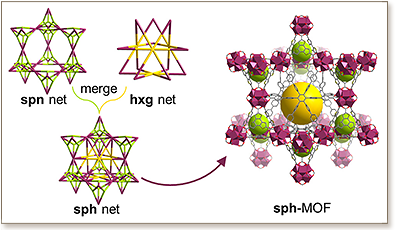

 Rational design and construction of metal–organic frameworks (MOFs) with intricate structural complexity are of prime importance in reticular chemistry. We report our latest addition to the design toolbox in reticular chemistry, namely the concept of merged nets based on merging two edge-transitive nets into a minimal edge-transitive net for the rational construction of intricate mixed-linker MOFs. In essence, a valuable net for design enclosing two edges (not related by symmetry) is rationally generated by merging two edge-transitive nets, namely (3,6)-coordinated spn and 6-coordinated hxg. The resultant merged-net, a (3,6,12)-coordinated sph net with net transitivity [32] enclosing three nodes and two distinct edges, offers potential for deliberate design of intricate mixed-linker MOFs. We report implementation of the merged-net approach for the construction of isoreticular rare-earth mixed-linker MOFs, sph-MOF-1 to -4, based on the assembly of 12-c hexanuclear carboxylate-based molecular building blocks (MBBs), displaying cuboctahedral building units, 3-c tritopic ligands, and 6-c hexatopic ligands. The resultant sph-MOFs represent the first examples of MOFs where the underlying net is merged from two 3-periodic edge-transitive nets, spn and hxg. Distinctively, the sph-MOF-3 represents the first example of a mixed-linker MOF to enclose both trigonal and hexagonal linkers. The merged-nets approach allows the logical practice of isoreticular chemistry by taking into account the mathematically correlated dimensions of the two ligands to afford the deliberate construction of a mixed-linker mesoporous MOF, sph-MOF-4. The merged-net equation and two key parameters, ratio constant and MBB constant, are disclosed. A merged-net strategy for the design of mixed-linker MOFs by strictly controlling the size ratio between edges is introduced.
Rational design and construction of metal–organic frameworks (MOFs) with intricate structural complexity are of prime importance in reticular chemistry. We report our latest addition to the design toolbox in reticular chemistry, namely the concept of merged nets based on merging two edge-transitive nets into a minimal edge-transitive net for the rational construction of intricate mixed-linker MOFs. In essence, a valuable net for design enclosing two edges (not related by symmetry) is rationally generated by merging two edge-transitive nets, namely (3,6)-coordinated spn and 6-coordinated hxg. The resultant merged-net, a (3,6,12)-coordinated sph net with net transitivity [32] enclosing three nodes and two distinct edges, offers potential for deliberate design of intricate mixed-linker MOFs. We report implementation of the merged-net approach for the construction of isoreticular rare-earth mixed-linker MOFs, sph-MOF-1 to -4, based on the assembly of 12-c hexanuclear carboxylate-based molecular building blocks (MBBs), displaying cuboctahedral building units, 3-c tritopic ligands, and 6-c hexatopic ligands. The resultant sph-MOFs represent the first examples of MOFs where the underlying net is merged from two 3-periodic edge-transitive nets, spn and hxg. Distinctively, the sph-MOF-3 represents the first example of a mixed-linker MOF to enclose both trigonal and hexagonal linkers. The merged-nets approach allows the logical practice of isoreticular chemistry by taking into account the mathematically correlated dimensions of the two ligands to afford the deliberate construction of a mixed-linker mesoporous MOF, sph-MOF-4. The merged-net equation and two key parameters, ratio constant and MBB constant, are disclosed. A merged-net strategy for the design of mixed-linker MOFs by strictly controlling the size ratio between edges is introduced.